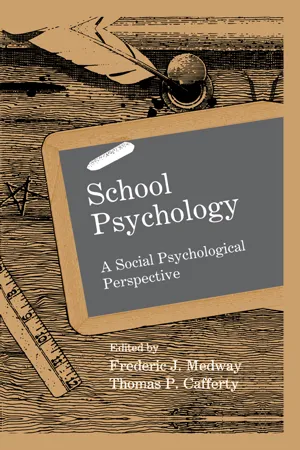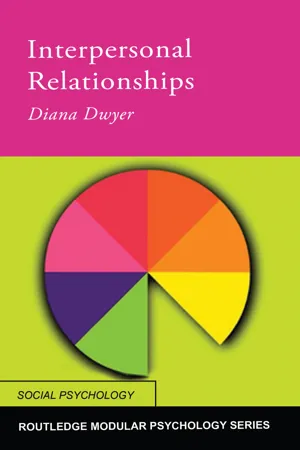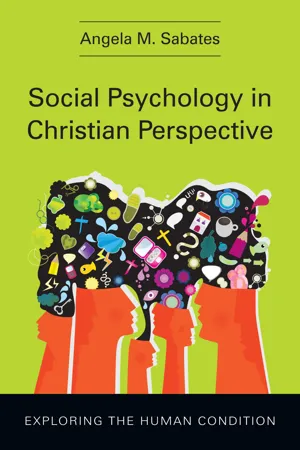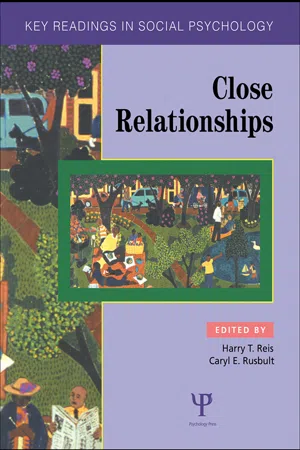Psychology
Factors affecting attraction
Factors affecting attraction in psychology include physical attractiveness, proximity, similarity, and reciprocity. Physical attractiveness plays a significant role in initial attraction, while proximity and similarity increase the likelihood of forming relationships. Reciprocity, or the mutual exchange of positive feelings and behaviors, also influences attraction by fostering a sense of connection and mutual interest.
Written by Perlego with AI-assistance
Related key terms
Related key terms
1 of 4
Related key terms
1 of 3
8 Key excerpts on "Factors affecting attraction"
- eBook - ePub
Applied Social Psychology
Understanding and Addressing Social and Practical Problems
- Jamie A. Gruman, Frank W. Schneider, Larry M. Coutts(Authors)
- 2016(Publication Date)
- SAGE Publications, Inc(Publisher)
In the next section, we consider the topic of interpersonal attraction, including what it means to feel attracted to specific others and some of the major determinants of attraction, such as proximity, familiarity, and physical attractiveness. In infancy, the process of attachment (the focus of the third section) might become our blueprint for developing later adult intimacy. The final section covers the selection process, which explores the qualities and experiences that draw us to others, what makes others seem attractive, and how we become closer. Circumstances sometimes throw people together. Simply enrolling in the same class as someone else, or happening to sit beside him or her can prompt interaction and liking, eventually friendship, and even love. Social psychology offers several principles to account for such transformations. The most consistent lesson of social psychology is the power of situational influences (see Chapter 1). Circumstances affect you. You live your life in a social context, considering and reacting to the events and conditions surrounding you. In human experience, thoughts, feelings, and actions are shaped, at least in part, by the social environment. Someone you run into frequently becomes more familiar—and more likable. Chris and Lee were pushed together by common circumstances (a small campus, the same class), and pulled together by mutual interests (perceiving common preferences in pastimes, developing shared friendships). Once attracted, they selectively perceived what they liked in each other and downplayed their differences. For example, Chris saw Lee as socially confident and skilled; only later did Chris recognize that Lee too had needs for reassurance and social acceptance. In addition to individual differences and personality characteristics (the subject matter of personality psychology), their fate is also shaped by situational influences and the social perceptions they support - Dominik Schoebi, Belinda Campos(Authors)
- 2019(Publication Date)
- Routledge(Publisher)
Annual Review of Psychology . In reviewing this literature, we were struck by how much these early works focused on attitudes. For example, Berscheid and Walster (1969) began their book with a long discussion of the concept and measurement of attitudes. Likewise, although Byrne and Griffitt (1973) did not refer specifically to attitudes, they devoted ample space to Clore and Byrne’s (1974; also see Byrne & Clore, 1970) model of attraction that conceptualizes the development of attraction as “an implicit affective response which is assumed to fall along a subjective continuum that is characterized as pleasant—unpleasant” (p. 328). Their model describes attraction in a manner that parallels the modern definition of an attitude—a summary association between an object and one’s evaluation of that object (see Fazio, 2007). Modern research has tended to move away from considering the role of attitudes in relationships, and we believe there is a lot of value in returning a bit to this way of thinking about attraction. Not only does the study of attitudes offer a large theoretical and empirical literature upon which to draw (see Cooper, Blackman, & Keller, 2015), considering these elements highlights the affective nature of attraction (see Zajonc, 1980). We return to this issue toward the end of this chapter.Over the subsequent decades, social psychologists organized the literature on attraction into five key factors: physical attractiveness, similarity, proximity, familiarity, and reciprocity. That is, we are attracted to others who are (a) physically attractive, (b) hold similar attitudes, (c) are easily accessible, (d) are familiar, and (e) like us. Berscheid summarized this early work in the first chapter on attraction for the Handbook of Social Psychology (1985), then in its third edition, added the notion of rewards—that is, we like others who have rewarding characteristics (i.e., attractiveness and similarity), can grant us access to such characteristics (i.e., are easily accessible and familiar), and who are willing to give us such access (i.e., like us).It is notable that much of this research did not focus exclusively on mixed-sex attraction but instead focused on why people like one another generally. For example, the idea that familiarity breeds attraction drew from work on mere exposure (e.g., Pliner, 1982; Zajonc, 1968), some of which was based on inanimate objects such as juices and Chinese characters. Much of the work on similarity drew from work on same-sex friendships (e.g., Izard, 1960; Newcomb, 1956). Even much of the work on physical attractiveness was based on liking that occurred between same-sex others (e.g., Cash, Begley, McCown, & Weise, 1975; Dion, Berscheid, & Walster, 1972) or evaluations of children (e.g., Clifford & Walster, 1973; Dion & Berscheid, 1974). One exception was a classic demonstration that physical attractiveness predicted wanting to see an opposite-sex date again (Walster, Aronson, Abrahams, & Rottman, 1966). The fact that early theories of attraction drew so heavily from research on non-romantic relationships likely stems from the fact that the study of interpersonal attraction was new and novel; there was much more research on non-romantic relationships from which to draw. Accordingly, this early work focused on general aspects of the social environment, including norms and pressures stemming from culture that shapes such preferences. The work seldom focused on sex differences in partner preferences (for an exception, see Stroebe, Insko, Thompson, & Layton, 1971), although early research did highlight one notable sex difference in the domain of similarity: women demonstrated a preference for older men whereas men demonstrated a preference for younger women (Bolig, Stein, & McKenry, 1984; Harrison & Saeed, 1977).- eBook - ePub
- Diana Jackson-Dwyer(Author)
- 2013(Publication Date)
- Routledge(Publisher)
3 Determinants of interpersonal attraction What this chapter will teach you • The main factors that determine with whom we make friends and form romantic relationships. • Why each of these factors is important. • Whether opposites attract or birds of a feather flock together. • Whether the internet has changed the way in which relationships are formed. In our everyday lives we meet a multitude of people but only form lasting relationships with a few. On what basis do we choose our friends and romantic partners? In this chapter, we consider research findings into the factors that help determine the onset of friendship or romance and the reasons why these factors may be influential. Proximity Proximity is a powerful force in interpersonal attraction; indeed probably the best predictor of whether two people will become friends is how far apart they are. Because of where people live, sit in a classroom or earn a living they have close contact with particular people, and it is this physical arrangement that is hugely influential in determining friendship patterns. In a classic study, Festinger et al. (1950) observed the friendships that formed in a block of apartments for married students consisting of seventeen separate buildings, each comprising ten flats on two floors. More than ten times as many friendships formed between students who shared the same building than between students in different ones. Within the same building, friendships were far more likely between people who lived on the same floor than between those on different floors. It was not only physical distance that made a difference: the most popular people were those who had apartments nearest the staircases and postboxes. This indicates that the functional distance, that is, the likelihood of two people coming into contact, is also very influential. In fact, as this study demonstrates, architectural features can significantly affect the likelihood that people will make friends - eBook - ePub
School Psychology
A Social Psychological Perspective
- Frederic J. Medway, Thomas P. Cafferty, Frederic Medway, Frederic J. Medway, Thomas P. Cafferty, Frederic Medway(Authors)
- 2013(Publication Date)
- Routledge(Publisher)
Because attraction and friendship formation among group members is an everyday social occurrence, it should not be surprising to find that social psychologists have a history of studying interpersonal attraction, friendship and group formation, and the socialization processes that occur in groups. This chapter reviews and overviews much of that research as we discuss how social psychologists have studied interpersonal attraction as well as the implications of social psychological research for education professionals.Social psychologists have brought several orientations to the study of attraction. First, they have tried to look at processes occurring within individuals (i.e., at the intraindividual level), particularly at how individuals react to cues from others such as dress, attractiveness, body posture, attentiveness, and so on (e.g., Berscheid & Walster, 1978; Maruyama & Miller, 1981). This literature has been called research on impression formation. Second, they have looked at interpersonal or interindividual behaviors, namely, how an individual’s reactions to another person affect the latter person’s reactions to the first person (e.g., Snyder, Tanke, & Berscheid, 1977), as well as how long-term interactions among individuals affect earlier impressions (e.g. Snyder & Swann, 1978). Third, they have looked beyond individuals to groups, studying, for example, the pressure that groups put on individuals as well as the ways that groups exert pressure (Asch, 1952; French & Raven, 1959). This work in particular has been tied to schools, for it provided one model to guide school desegregation (e.g., Maruyama, Miller, & Holtz, 1986). Fourth, they have looked in detail at the development and consequences of peer relationships (e.g., Hartup, 1983). In effect, a number of complementary approaches have combined to provide a broad perspective for viewing interpersonal attraction and interpersonal relationships in group settings. This chapter tries to summarize those approaches, beginning with a discussion of the importance of interpersonal attraction.Importance of Interpersonal AttractionFirst, interpersonal attraction can aid in processes of socialization. Socialization occurs in families, in church and community groups, in neighborhoods, and in schools; because the present volume is oriented to issues of school psychology, we focus on socialization in schools. Educators have described a number of important functions that schools serve beyond teaching academic skills. Socialization, acculturation, and value transmission are prominent examples. These functions often have been addressed implicitly and given labels like the hidden curriculum - eBook - ePub
- Miles Hewstone, Wolfgang Stroebe, Klaus Jonas, Miles Hewstone, Wolfgang Stroebe, Klaus Jonas(Authors)
- 2016(Publication Date)
- BPS Blackwell(Publisher)
Ample research shows that physical and psychological factors that people are unaware of play a powerful role in determining who people affiliate with, and ultimately even develop close relationships with. An important but underestimated factor that reliably affects people’s relationship choices and relationship development is proximity, that is, whether people are near to each other in place or time. The most important psychological factors are familiarity and similarity. These three factors – proximity, familiarity, and similarity – are closely related to one another, as we will show.Proximity
When moving into a student house or building, many students may choose to live as far away from the elevator or stairs, kitchen or restrooms as possible. They hope that this will offer them a quieter location where they can work and sleep undisturbed. Although this consideration may have some merit, it may also reduce the likelihood of making many friends. Indeed, research shows that proximity, or being physically close to others (sometimes called ‘propinquity’), increases the chance of becoming friends with them.One of the most informative studies on the power of proximity is the pioneering study by Festinger, Schachter, and Back (1950). These authors examined relationship development among a sample of student couples that were assigned to apartments for graduate students in Westgate West, an apartment complex with different buildings and apartments on different floors. Over the course of 10 months, physical proximity predicted the development of friendships: people formed more friendships with others who lived physically close to them than with people who lived further away. For example, people were 10 times more likely to become friends with others in the same building than with people in a different building; within each building, people who lived on the same floor had more friends on the same floor than on a different floor; and people on the same floor were more likely to become friends with their next-door neighbours than with people who lived further down the corridor. It should be noted, however, that proximity did not always promote liking. In some cases, people also increasingly disliked their neighbours. After all, to like or to dislike someone, and even to love or to hate someone, one needs to know the other person. Proximity allows people to get to know others, for better and for worse. - eBook - ePub
- Diana Dwyer(Author)
- 2013(Publication Date)
- Routledge(Publisher)
4 Theories of interpersonal attractionLearning theory Social exchange theory Equity theory Sociobiology In Chapter 3 we saw that certain factors, in particular proximity, similarity and physical attractiveness, are important in the formation of friendship and romantic relationships. In this chapter we will explore some of the theories that seek to explain why these and other factors may be of importance in the formation, maintenance and perhaps dissolution of such relationships.Learning theory
Byrne and Clore (1970), in their reinforcement-affect theory, argue that both classical conditioning and operant conditioning help to forge friendships and romantic liaisons. Classical conditioning involves learning by association, so that a neutral stimulus produces an emotional response. We may learn to associate the sound of a dentist’s drill with fear, even though the sound has never hurt us. Operant conditioning involves learning by consequences, so that we are more likely to do things that are reinforced and less likely to do things that that are punished.The effect of classical conditioning on liking
In terms of classical conditioning, we like people with whom we associate enjoyment and satisfaction, even if they are not directly responsible for these positive experiences. If we meet people under pleasant circumstances, such as seeing them regularly at our local pub, we are more likely to be attracted to them than to those whom we meet under disagreeable situations such as at a tedious series of committee meetings. Evidence to support this is offered by a study by Veitch and Griffith (1976), who demonstrated that people who interacted with a stranger against a background news programme of all good news rated the stranger more positively than those interacting with a stranger while listening to a news broadcast full of depressing news items. - eBook - ePub
Social Psychology in Christian Perspective
Exploring the Human Condition
- Angela M. Sabates(Author)
- 2012(Publication Date)
- IVP Academic(Publisher)
There are several early studies that demonstrated the power of physical attractiveness on liking. For example, Hatfield and her associates (1966) gave personality and aptitude tests to a sample of first-year students at the University of Minnesota. The researchers then randomly matched 376 couples for an arranged dance. After spending two and a half hours at the dance with their assigned partners, students were asked to evaluate their dates. Examining a long list of psychological traits, the only significant factor that seemed to predict liking was physical attractiveness. This was true for both men and women.In terms of defining the ideal romantic partner, one of the most reliable findings in social psychology research on interpersonal attraction is the overwhelming influence of physical attractiveness. Singh (2004) reviews many of these studies whose findings suggest that both men and women express a preference for an attractive partner in noncommitted short-term relationships such as one-night stands or other casual dating relationships (e.g., Hatfield & Sprecher, 1986; Jackson, 1992). What about for long-term relationships? Buss (1999) notes that for committed relationships, if the male has high social and financial status, females appear to relax their standards for the partner’s attractiveness. Males also tend to look for various personality qualities (e.g., kindness, good parenting skills) in potential long-term partners. However, unlike females, males still assign relatively greater importance to physical attractiveness compared to other personal qualities.Singh (2004) also cites another study that demonstrates the powerful effect of physical attractiveness on males’ choice of romantic partner. Li, Bailey, Kenrick and Linsenmeier (2002) gave male subjects a limited “mating budget” in which they were asked to allocate various characteristics of a female their respective weights in the equation. The findings showed that the males allocated the largest proportion of their budget to physical attractiveness rather than to other attributes such as an exciting personality, liveliness and sense of humor. Li et al. suggest that in this case, the males had assessed female attractiveness as a necessity in romantic relationships. - eBook - ePub
Close Relationships
Key Readings
- Harry T. Reis, Caryl E. Rusbult, Harry T. Reis, Caryl E. Rusbult(Authors)
- 2004(Publication Date)
- Psychology Press(Publisher)
Journal of Experimental Research in Personality , 1969, 3, 179–186.Byrne, D., Griffitt, W., & Stefaniak, D. Attraction and similarity of personality characteristics. Journal of Personality and Social Psychology , 1967, 5, 82–90.Byrne, D., London, O., & Reeves, K. The effects of physical attractiveness, sex, and attitude similarity on interpersonal attraction. Journal of Personality , 1968, 36, 259–271.Byrne, D., & Rhamey, R.Magnitude of positive and negative reinforcements as a determinant of attraction. Journal of Personality and Social Psychology , 1965, 2, 884–889.Efran, M.G. Visual interaction and interpersonal attraction. Unpublished doctoral dissertation, University of Texas, 1969.Griffitt, W.B. Interpersonal attraction as a function of self-concept and personality similarity-dissimilarity. Journal of Personality and Social Psychology , 1966, 4, 581–584.Griffitt, W.B. Environmental effects of interpersonal affective behavior: Ambient effective temperature and attraction. Journal of Personality and Social Psychology , 1970, 15, 240–244. (a)Griffitt, W.B. Personality similarity and self-concept as determinants of interpersonal attraction. Journal of Social Psychology , 1970, in press. (b)Huffman, D.M. Interpersonal attraction as a function of behavioral similarity. Unpublished doctoral dissertation, University of Texas, 1969. McWhirter, R.M., Jr. Interpersonal attraction in a dyad as a function of the physical attractiveness of its members. Unpublished doctoral dissertation, Texas Tech University, 1969. Megargee, E.I. A study of the subjective aspects of group membership at Amherst. Unpublished manuscript, Amherst College, 1956. Moss, M.K. Social desirability, physical attractiveness, and social choice. Unpublished doctoral dissertation, Kansas State University, 1969.Perrin, F.A.C. Physical attractiveness and repulsiveness. Journal of Experimental Psychology
Index pages curate the most relevant extracts from our library of academic textbooks. They’ve been created using an in-house natural language model (NLM), each adding context and meaning to key research topics.
Explore more topic indexes
Explore more topic indexes
1 of 6
Explore more topic indexes
1 of 4







